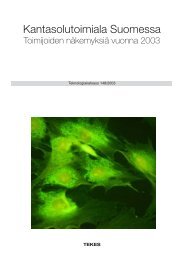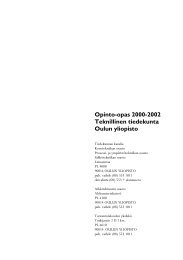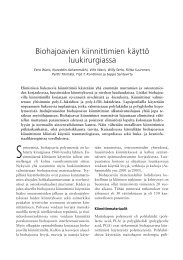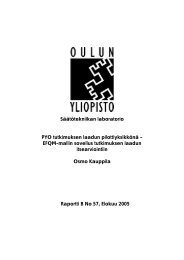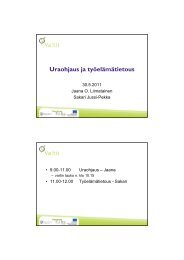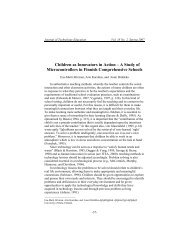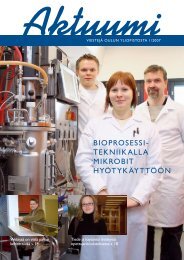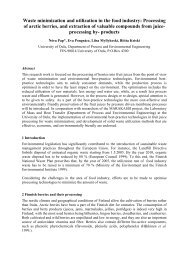Industrial Ecology in the metallurgy industry The Harjavalta ... - Oulu
Industrial Ecology in the metallurgy industry The Harjavalta ... - Oulu
Industrial Ecology in the metallurgy industry The Harjavalta ... - Oulu
You also want an ePaper? Increase the reach of your titles
YUMPU automatically turns print PDFs into web optimized ePapers that Google loves.
Besides <strong>the</strong> primary metals of copper and iron, <strong>the</strong> concentrate aslo <strong>in</strong>cludes smaller amounts of<br />
different heavy metals (Ni, Zn, Pb, Co, As, Sb, Bi, Ag and Au). In <strong>the</strong> case of copper, <strong>the</strong> general<br />
concept of process is: f<strong>in</strong>e dry copper sulphide concentrate and quartz sand as flux are blown<br />
<strong>in</strong>to a hot hearth furnace with oxygen (<strong>in</strong>dustrial), oxygen-enriched air. <strong>The</strong> products are a Cu-<br />
Fe-S matte, SO 2 enriched off-gases, and slag. <strong>The</strong> ma<strong>in</strong> reaction is:<br />
2 CuFeS 2 + 4O 2 ⇔ Cu 2 S + 2FeO + 3SO 2 (1)<br />
<strong>The</strong> matte is fur<strong>the</strong>r processed <strong>in</strong> a Peirce-Smith converter to obta<strong>in</strong> <strong>the</strong> metallic copper. <strong>The</strong> slag<br />
is treated to recover its 2 % copper content. <strong>The</strong> off-gas conta<strong>in</strong>s about 10 - 75 percent by<br />
volume SO 2 . Heat<strong>in</strong>g needed for smelt<strong>in</strong>g is obta<strong>in</strong>ed from <strong>the</strong> exo<strong>the</strong>rmic reaction of oxidiz<strong>in</strong>g<br />
<strong>the</strong> Fe and S <strong>in</strong> <strong>the</strong> feed. <strong>The</strong> reaction is (Luomala 2002);<br />
[ FeS] + 3 O = ( FeO)<br />
+ SO<br />
2 2 2 (2)<br />
<strong>The</strong> iron forms with quartz fayalite slag:<br />
2FeO + SiO2<br />
= 2FeO ⋅ SiO2<br />
(3)<br />
<strong>The</strong> SO 2 is recovered and treated to make ei<strong>the</strong>r SO 2 or H 2 SO 4 . <strong>The</strong> recovery of by-products and<br />
recycl<strong>in</strong>g of dust and wastewater have an important effect on <strong>the</strong> environment, because dusts and<br />
wastewater conta<strong>in</strong> quite a lot of heavy metals.<br />
<strong>The</strong> <strong>Harjavalta</strong> Copper DON process elim<strong>in</strong>ates <strong>the</strong> convert<strong>in</strong>g stage altoge<strong>the</strong>r and thus greatly<br />
simplifies <strong>the</strong> nickel process. High-grade matte is produced us<strong>in</strong>g only <strong>the</strong> flash smelt<strong>in</strong>g furnace<br />
and electric furnace – without Peirce-Smith converters. <strong>The</strong> SO 2 is recovered and treated <strong>in</strong> <strong>the</strong><br />
same sulphuric acid plant as is <strong>the</strong> gas from copper smelter. <strong>The</strong> elim<strong>in</strong>ation of converters<br />
reduces <strong>the</strong> <strong>in</strong>vestment, operat<strong>in</strong>g and ma<strong>in</strong>tenance costs significantly. <strong>The</strong> nickel flash smelt<strong>in</strong>g<br />
flow sheet is shown <strong>in</strong> Figure 2.<br />
Figure 2 <strong>The</strong> nickel flash smelt<strong>in</strong>g flow sheet.



